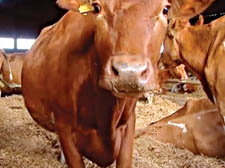|
|
 |
| |

From BBC4’s Mud, Sweat and Tractors: the Story of Agriculture |
How now brown cow?
Fond memories of dairy cows prompt Clare Latimer to take a critical look at modern methods of milk production
LAST week I watched a superb programme on the history of milk in this country (first of a four-part series – Mud, Sweat and Tractors, BBC4 Wednesdays 9pm).
The old film footage was wonderful, with women in long skirts doing the milk rounds and all the farm animals intertwining with the farming family and even little children taking the cows out to the pastures at the end of the day.
I have had a passion for diary cows since I was five and remember those days with great affection.
I moan on these days about the appalling black and white Holstein cow – Friesian – we have bred that is very tall, skinny and has such an oversized udder that not only does this harm its back but splits its back legs open causing lameness; then, adding insult to injury, we keep them indoors – on concrete in many farms – and their lifespan is very short.
Due to the price of milk now being set by supermarkets it is generally non profit-making to produce milk and the majority is not only pasteurised to kill any bacteria but homogenised which prevents the cream lying on the top of the milk. By buying more expensive milk, and it is not that much more, you are giving more to the farmer as he will be breeding fewer yield-producing cows such as Guernsey, Ayrshire or perhaps the lovely Jerseys with their huge eye lashes and also they will almost certainly be grazed on grass in fields and be allowed to chew their cud while peacefully lying in the sun. You can buy milk fresh from the cow without any treatment from farmers’ markets.
The other awful thing the Holstein has done is to unbalance the milk: meat ratio as bull calves are not worth rearing so are shot at birth.
Some vegetarians will eat dairy but not eat meat which also means killing calves at birth. I am pro vegetarians as there is room for all of us – but keep off the dairy.
Here are two recipes to set the balance:
Beef stir fry
This is very quick and best served with noodles or rice – and a glass of chilled lager!
Ingredients – serves 4
3 tbsp peanut oil
300g sirloin steak, cut into strips
2 cloves garlic,
peeled and crushed
1 tbsp fresh ginger, peeled and grated
1 chilli, chopped and seeds removed
3 carrots, peeled and cut into thin strips
1 small head broccoli, cut into small florets
Juice of 1 lime
1 tbsp fish sauce
1 handful fresh coriander, chopped
2 spring onions, chopped.
Method
Heat a large frying pan or wok to a high heat and add the oil, meat and garlic. Stir fry on high heat for about three minutes. Remove meat to a plate. Add the ginger, chilli, carrots and broccoli to the pan and fry for about five minutes or until the vegetables are cooked. Add the cooked meat and the rest of the ingredients and serve hot.
Honeycomb mould
This dates to the 1750s some 50 years ago I benefited from it; now I have added some “modern” extras. Dip in hot water to turn out if difficult.
Ingredients
Serves 6
600ml full fat milk
3 free-range eggs, separated
25g caster sugar
1 teasp runny honey
Few drops vanilla essence
1 desp gelatine
2 tbsp water
Freshly grated nutmeg.
Method
Put the milk into a saucepan and bring to the boil.
Put the egg yolks and caster sugar into a bowl and pour on the milk whisking well.
Add the honey and vanilla essence and then pour the mixture back into the saucepan and whisk over a low heat for a few minutes.
Soak the gelatine in the water for a few minutes, heat very gently until runny and then stir it into the milk mixture.
Leave to cool for 15 minutes.
Whisk the egg whites until very stiff and fold them into the cool custard. Pour into a glass bowl or mould and leave to set in the fridge.
Turn out when ready to eat or serve from bowl. |
 |
|
|
 |

|
|
 |
|









